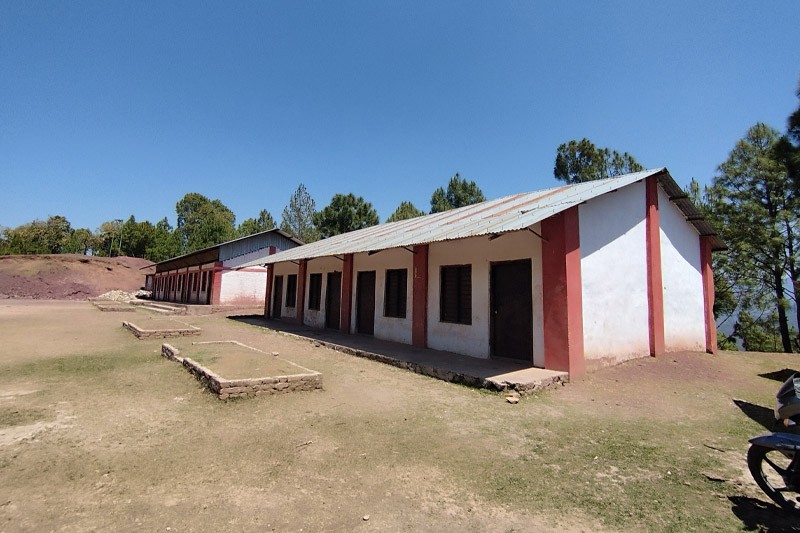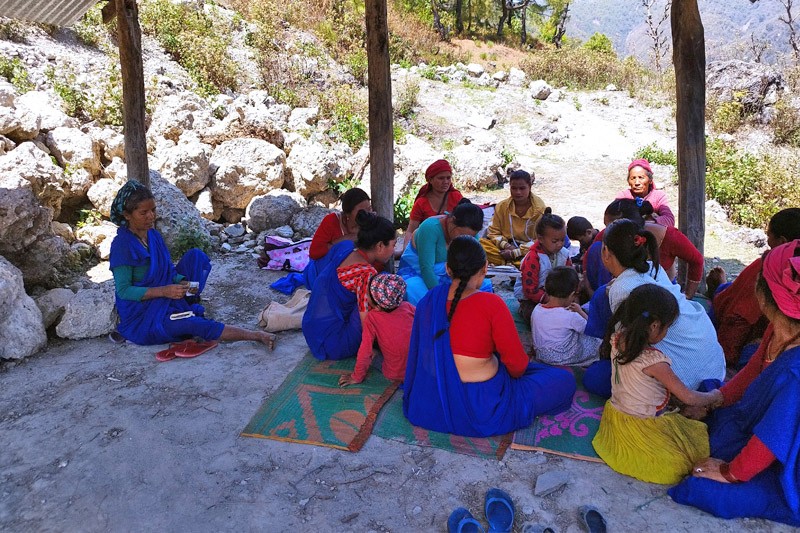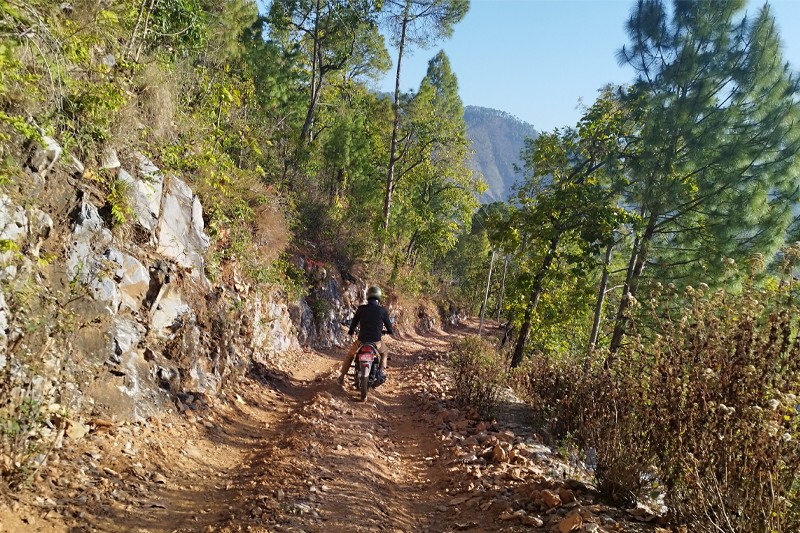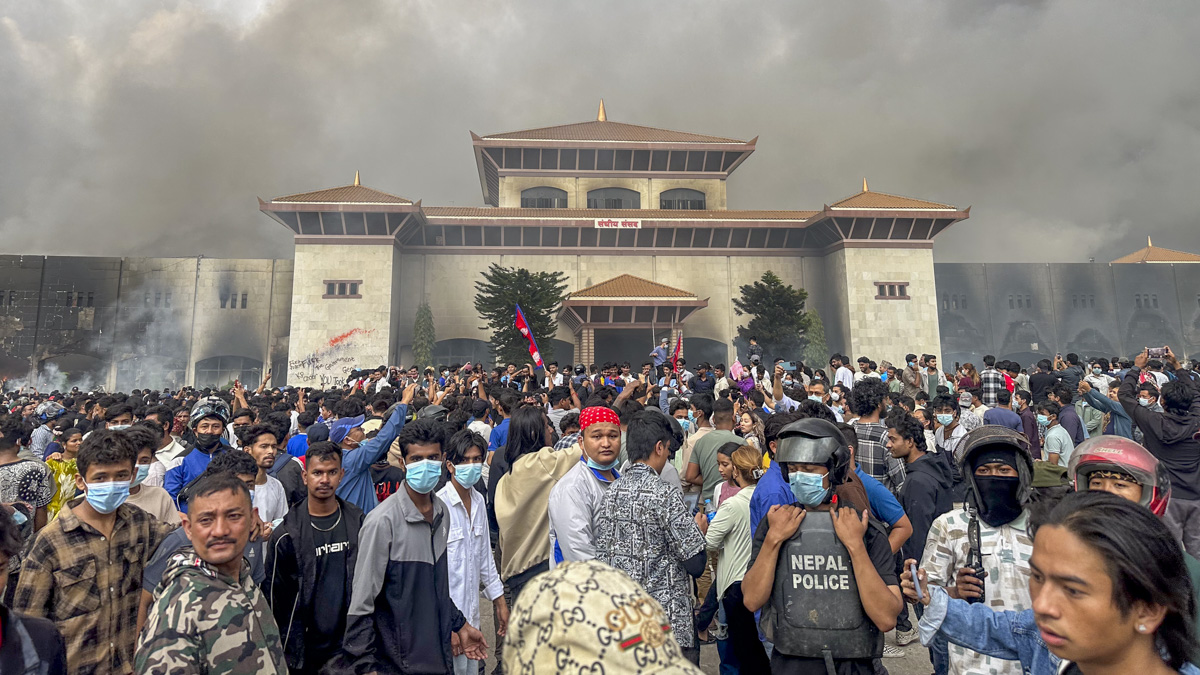Keshara Pun, the mother of five (three sons, two daughters) is in her dotage. At 81, all of her hairs have gone gray, wrinkles cover her cheeks and most of her teeth have fallen. She is alone at this stage of life when care is paramount . The only person to accompany her at this age is her grandson (the son of her eldest daughter) at her home in Bangalachuli Rural Municipality-4, Gadari—a village northeast of Ghorahi, the district headquarters of Dang which is one hour of bus ride and two hours of walk from the district capital. “None of my sons are here with me. I might die and they will not be able to see me before that,” she says.
It has been a long time since Pun, who lives in a thatched hut, lost her husband. Her sons, who could have taken care of her at this age, left for employment in India, continuing the practice followed by their father. “Their father also would go to India to find seasonal work,” she recalls. “We raised these children with the money he sent home from there.”
Kesara’s sons followed in the footsteps of their father by taking their own sons along with them . They had a compelling reason for this.
Kesara had a piece of land but it did not produce enough to feed the family for more than eight months. For the remaining four months of the year, they had to buy food grains to feed themselves from the market. But now, even that small piece of land lies barren because there is nobody to till it, for all her sons are in India.
The story of Kesara is a representative story of nearly all families in Gadari village that has 31 households. The youths from 29 households have left for employment either to India or other countries. Two of the families abandoned their homes and migrated to other places this year. Since no young male members are present in the village, they have to call out to the men from another village when they need to perform a death ritual, which is traditionally performed by men.
Bhim Bahadur Thapa, 70, from Gadari village has a similar story to share: Two of his sons are out in Europe and a daughter-in law lives in another city to educate the children. She sends tidbits home from where she lives, which then Thapa uses as goods to sell in his small shop that he has set up. He recalls the days when the villagers had enough to feed themselves from the harvest of their own land. This was the case, at least, until 1977. “There were more than 100 bighas (1 bigha=0.62 acres) of land in total. They raised cattle and goats whose dung was used as manure in the field to grow rice, maize, wheat and mustard,” says Thapa. The villagers built a dam in the local Rupala river for irrigation. People exchanged labors and farming thrived. Only when there was little to do in the field, some of the men would go to India to generate additional income. Mostly, they sold ghee, goats and chickens, and the money generated from the sale was used to manage household expenses.
All this feels like a fairytale to him now.
Although Gadari is only 32 kilometers away from the district headquarters, it is still not connected with the road network—the road track opening work has just started. As such, if someone falls ill, they have to be carried on people’s backs and taken to the hospital. As there is no road to the village, people there do not feel any semblance of development. This is one major reason why the young leave the village, according to Goma Kunwar, 70. “Only elderly are left in the village. Youths have gone to India for earning. Children are in towns to attend schools,” says Kunwar.
Migrating to town-areas for educating the children is a compulsion rather than a choice for the village folks here. Early grade school (which runs class only up to grade one) is the only educational institute they have in the village. To complete primary level education, they have to walk for an hour on foot to a local primary school—Sri Tribhuvan Primary School. To attend senior classes, they have to walk for two hours to reach Sri Ambika Secondary School in Harnok, where one can study up to grade 10. If you are to study at higher grades, you have to trek down to Ghorahi, the district headquarters. The consequence of this has been predictable—those who cannot afford to send their children to far-off places give up. Others who can rent rooms in district headquarters choose to educate their children there. This is another reason why people abandon Gadari.

To their relief, the village has recently been connected with electricity and water supply services but this does not seem to stop the migration flow. "The village is emptying because the state has failed to integrate the village with the modern agriculture system," says Bhim Bahadur Thapa. According to him, the village grows herbs and fruits such as ginger, turmeric, Sichuan pepper and other fruits but due to a lack of proper management of these products, the villagers have not been able to generate income. “Since there is no income generating work in the village, the number of people going to India for jobs has increased. As there are no canals and dams for irrigation, all lands remain barren,” says Thapa.
As youths have left the village, a little tilling the elderly manage to do with their own sweat often goes to waste as wild boars and monkeys destroy the crops. Farming is like a punishment, a self-invited trouble for Rukmati Thapa, 69. “Whatever little wheat, maize, rice and mustard we grow is eaten up by boars,” she says. “Farming feels like an additional trouble.”
Local government representatives admit to their inability to do anything substantive to contain the monkey-boar menace, which is destroying the crops of the villagers. “We cannot kill wild animals. We shoo them away but they come again,” says Das Bahadur Dangi, the ward chair of Bangalachuli-4. “We have been like mute spectators.”

Thapa attributes the increasing rise of wild animals in the farming fields to the declining number of people in the village. And since farming has suffered in the village, people have no other option than to feed themselves by purchasing the food grains from the market.
According to Prithvi Raj Lamichhane, the economist and agriculture expert at Agricultural Knowledge Center, Dang, there are total of 5261 hectares of arable land in Bangalachuli Rural Municipality, of which 593 hectares are the field and 4668 hectares of it is slope- land (suitable for growing maize and wheat). According to the district-based Center, paddy rice grows in 1143 hectares of land, maize grows in 3871 hectares and wheat in 347 hectares. The rural municipality has no statistics of the land area which is still cultivated and the land area that has been left barren.
Cheaper to buy than to produce
The tale of Gadari is a tale of most parts of Nepal. Young people go abroad, only elderly people are left behind and the land remains barren. Experts say that the phenomena is serious. “Land is being left barren and this trend is increasing every day,” says Krishna Paudel, an agriculture expert.
According to Agriculture Census 2022, a total of 4,130,789 households in Nepal have been doing farming works on 2,218,410 hectares of land. According to the 2012 census, a total of 3,831,093 farmer households were involved in farming on 25639 hectares of land. This shows that in ten years, 299,096 farming families have been added. But the 2022 census shows that a total of 307,229 hectares of land are barren, of which some have been used for land plotting, housing, industries and manufacturing. The 2022 census also shows the decline in the area of land cultivated with temporary crops and permanent crops. In ten years, temporary crop land area has declined by 392,000 hectares and permanent crop land area by 23,000. Temporary barren land has increased by 95 percent to 60,542 hectares, the forest/bush area has increased by 46.9 percent to 80,669 hectares, according to the 2022 census.
Experts do not attribute abandonment of land to youths leaving the country alone. “Women and elderly can also work but they don’t,” Paudel says. “Cultivable land has become barren because people see no income prospects in agriculture nor does agriculture ensure subsistence.” According to him, farmers do not get fertilizers and seeds on time and purchasing food grains from the market has become cheaper than growing it on one’s land, leading to a declining trend of people doing farming.
Dangi, the chair of Bangalachuli Rural Municipality-4, thinks that desertification of land could be corrected if the youths could be engaged in income generation in the village itself, but he says that the federal government itself should bring out a concrete plan for this. “We cannot work with the small budget from the local government. We have not been able to bring out a concrete program to hold the youths back in the village,” he says. He strongly stands in favor of creating jobs and income generation in the village itself since youths leave the village for no other purpose than earning.
Dangi says that the Prime Minister’s Employment Program provided short-term jobs to five youths in Fiscal Year 2023/24, but he has not been able to initiate any model program due to lack of funds. “Last year the municipality allocated 20 percent of the budget for the agriculture sector but this could suffice only for providing for vegetable seeds,” Dangi says.
Asmita Timalsina, Chief of Agriculture Department at Bangalachuli Rural Municipality, says that the municipality has been implementing programs related to the modern agriculture system like motivation programs to cultivate the barren lands among others so as to make the residents of the municipality self-reliant. She also says that the municipality distributes vegetable seeds for free. “Under one village and one agriculture project scheme, we conducted farmers-technician meetings in every settlement,” says Timalsina.
According to her, the municipality has initiated the work to develop goat farming, buffalo farming, bee farming and poultry farming as industries by identifying the prospects of these sectors.
Reversing the trend is possible
Experts say that the government needs to take measures to retain human resources in the rural settings to recultivate the barren lands. Sharad Kumar Acharya, Professor of Population and Social Studies in Nilakantha Campus of Tribhuvan University, argues the government needs to create an environment to keep people rooted to their villages. According to him, making vocational education (suitable to the soil and environment) free and accessible, modernization in agriculture, commercial livestock farming, ensuring proper market and transportation facilities can help create the situation to keep the youths engaged in the villages.
Paudel, an agriculture expert, stresses on the need for the government to allocate budget to each ward so as not to keep the land uncultivated. “The government needs to bring farmer-friendly programs in such a way that the real genuine farmers are benefited. They need to be encouraged to do farming that suits the soil and environment,” says Paudel.
Professor Acharya suggests that federal, provincial and local governments need to work to integrate the community forests under their jurisdiction with income generation and productive farming.
Dangi, the Ward Chair of Bangalachuli-4, says that the federal government needs to bring programs to address the employment needs of the youths from backwater municipalities.
Misplaced priorities
Locals are of the view that the Bangalachuli Rural Municipality, where majority of land area falls in the hill and mountain territory, has not been able to work to address the needs and problems of the local people.
The local government elected in 2018 allocated 20 million rupees in the name of tourism development but built view towers and other infrastructure with that budget. Radha Pun, 22, a resident of Gadari comments, “People’s needs are one, but the local government’s priorities are in other areas.” She is of the view that the elected representatives have overlooked what matters the most to the local people- schools, industries, and roads.

Tulasi Ram Pun, the Chairperson of Bangalachuli Rural Municipality, concedes that people’s living standard has not changed in the region because of lack of road infrastructure. He, however, claims that the municipality is working to expand the road network by opening 200 kilometers of new road tracks in backward areas and by upgrading road infrastructure wherever it has been built. “It’s been really difficult to address the minimum basic needs of the people with inadequate budgets from the local government,” he says. “We will be able to provide other services if the federal and provincial governments lend support.”
Pun, however, is of the conviction that if the villagers are provided with basic facilities, outmigration can be stalled and the barren land in the village can be cultivated to produce crops.
Read our guidelines for Republishing this story here.



